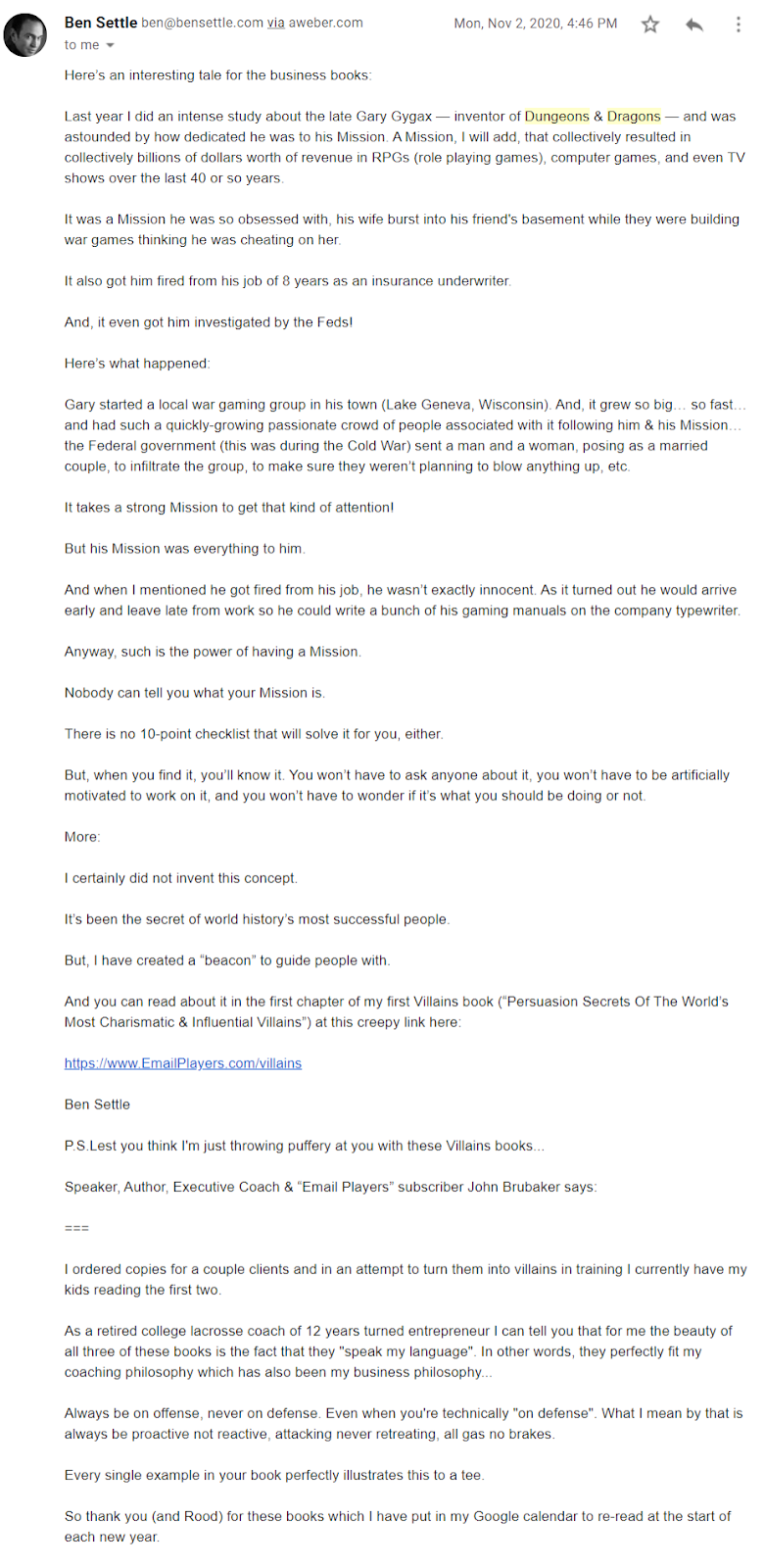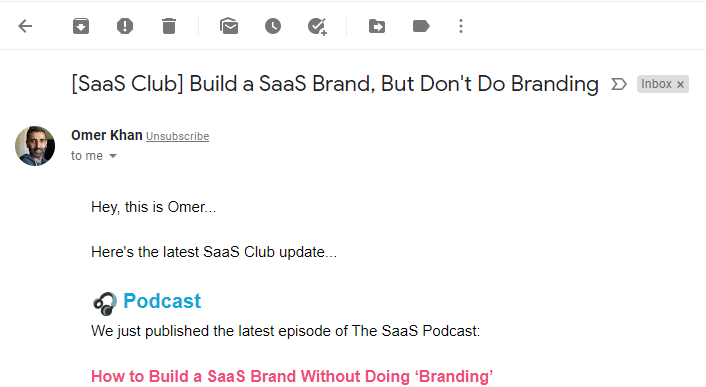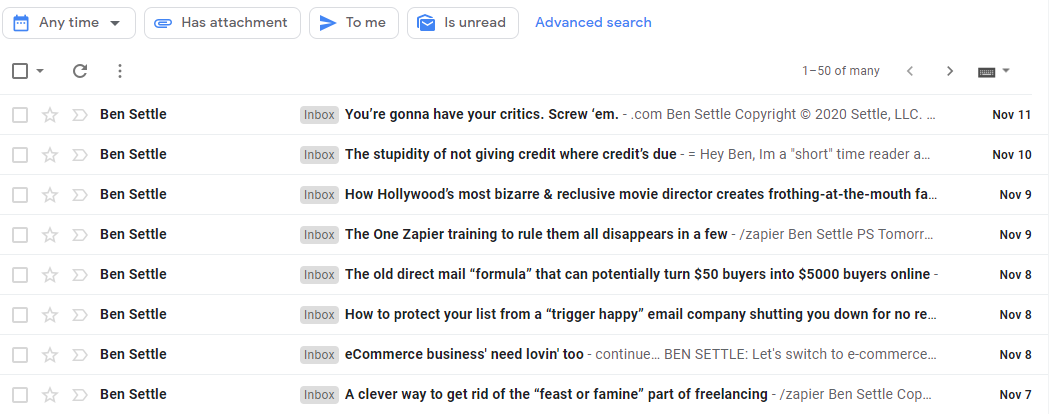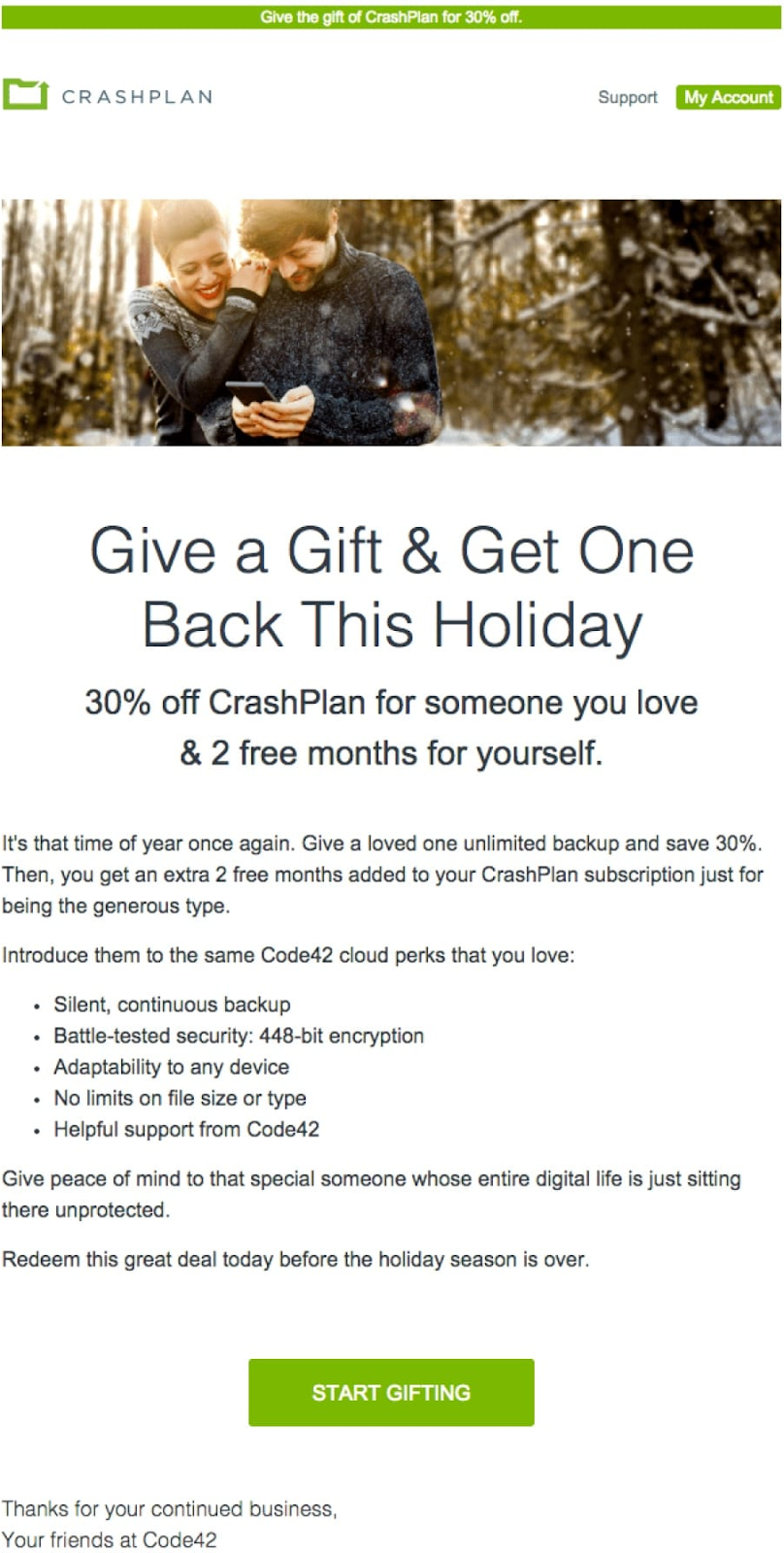Email is one of the most powerful marketing channels in existence.
And when you combine it with persuasive copy, results can get explosive.
Studies have shown that email marketing can produce an average return of $42 for every $1 spent, demonstrating how much ROI potential this channel has.

But investing in your email marketing strategy won’t get you that ROI right away.
Some brands net millions of dollars from email alone. BuzzFeed, for instance, is known for its extensive email marketing tactics, which is one of the top referrers for its web traffic. Others may not prefer to invest in email marketing, believing it to be outdated or ineffective.
The key for those brands that succeed is to know how to write persuasive emails.
This guide will give you a simple blueprint on how to write emails that generate revenue.
The same blueprint I’ve used for all my emails, from guest posting to landing top-notch clients.
So if you’d like to upgrade your email copywriting game, keep reading and pay close attention to the principles I’m going to give you.
Table of Contents
6 steps to construct a persuasive email
The framework I use to write persuasive emails can be divided into six steps.
If you follow these steps, you’ll be able to write emails that are — at least — decent (you can only get better with practice).
Step 1. Have a specific goal in mind
Before writing, determine the purpose of the email.
Ask yourself:
- What’s the action I want my audience to do?
- What do they need to think, believe, and feel in order to take the action?
- Why do they need to act now and not later?
Regardless of what type of email you’re writing, defining a goal is crucial if you want your emails to be high converting.
Whether it is nurturing your audience, segmenting your list, promoting a post, or plain old selling, you always need to create your emails with the next action in mind.
Step 2. Construct your conclusion first
Copy is created backwards.
You need to determine your email’s conclusion, tied to the goal you set up earlier, before you write.
The conclusion is more than the marketing message you want your audience to consume — the set of knowledge and beliefs you want them to have so they can take proper action.
If you’ve done your research correctly, you don’t need to come up with marketing messages. You already know what your audience wants, what they know, and what they’re willing to do to get your offers.
Step 3. Build the body of your email
Once you have defined your goals for the email, you can start writing the body.
Here’s when you can start using the AIDA formula (found below) and start outlining your email.
You’ll often wonder: “what should I write about?” (need some more inspo?)
It depends on the purpose, the email format, and the marketing message you want to deliver.
So if you’re promoting a recent post in your blog, you know that you’ll need to write about the importance of the content’s topic, etc.
A great way to do this is by incorporating storytelling into your offer.
Stories are very effective marketing tools, and they make your marketing message easier to digest for your audience.
Ben Settle uses stories all the time; you can even tell that stories are key in his business.
Here’s, for example, how he tells the story of the inventor of Dungeons & Dragons as a way to teach the importance of having a mission:

Stories are used all the time to tell big ideas — and you should capitalize on them.
Sometimes starting is the hardest part, here’s 10 templates to get you off the blank page. And here’s 21 Business Emails you can copy and paste.
Step 4. Strengthen your pitch with evidence and examples
It doesn’t matter how much of an individualist you think you are; the reality is people tend to do what others do (known as The Bandwagon Effect).
Social proof is a powerful way to convince your audience that your offer is legit and that you’re not lying about the results you say it gives.
Including evidence and social proof in your persuasive emails has many forms, such as:
- Case studies from customers who represent your target audience.
- Commentaries from people who tried your offer.
- Quotes from a book or an authority figure that validates the idea you’re selling.
- Feedback or conversations you had with someone important in your industry.
- Actual reviews you’ve got from loyal customers.
You need to put a little bit of work to get these. But when you apply them, the difference is huge.
You can see how Roy Furr used a conversation he just heard to validate a point and sell the topic of the YouTube video he was promoting.

Of course, he has the authority to use an anonymous quote to validate a point (you’re trusting his words), but it demonstrates how flexible a validation can be.
Step 5. Emphasize your CTA
Do not limit yourself to one CTA.
Sometimes, a reader is ready to click earlier than you think.
To boost your click-through rates, integrate effective CTAs throughout the entire email.
But where can you place the CTAs?
The most common places are:
- The end of the email.
- After introducing the email (when you already got your reader’s interest).
- Whenever the next action is mentioned or referred to.
- In the P.S.
It’s worth mentioning that the P.S is your last chance of getting the readers to act. It’s a good idea to write a P.S if you want to optimize your click-throughs (people are lazy, and sometimes they just read the P.S.).
CTAs are a great place to use persuasive words too.
To cap off, make sure you proofread the body of your email for any grammatical errors or typos. The last thing you want is to lose out on converting a customer because of one misplaced comma.
Step 6: Create a smart, actionable subject line
The last step is writing a subject line that gets clicked.
What you need to remember about the subject line is that its only job is to grab the reader’s attention and compel them to open the email (without click-baiting and making false claims).
Some good practices for subject lines include:
- Avoid using spam-like words like “FREE,” “Now,” or “Discount,” or it will hurt your email deliverability.
- Do Not Capitalize The Subject Like This, or it will sound like a promo.
- Personalize with the recipient’s names or with segmentation.
- Use techniques to catch curiosity.
A great example of an intriguing subject is from a persuasive email from Omer Khan from SaaS Club.

Anyone who reads that subject will wonder, “how can you build a brand without branding?”
And he uses that intrigue to send people to his podcast, where he talks about said topic.
You can find many excellent subject line examples in your inbox if you just think about the last emails you opened.
Pro tip: I recommend learning about subject lines and then tinkering around with different variations for best results. You can even test your subject lines before you send them.
The importance of persuasive emails
Writing marketing emails is all about getting your reader from state A to state B.
When they engage with your emails, your audience is (more likely) in the consideration stage of your sales funnel. You want your email to get your prospective customer from Stage A, the consideration stage, to stage B, the purchase stage.
To do this, you need to know how to sell.
See, there are three fundamental principles for selling:
- People don’t like to be sold to.
- People buy based on emotion.
- People use logic to justify their emotions.
When you understand these principles, you know that the importance of writing persuasive emails lies in not letting your audience feel like you’re selling them something.
Do this by providing them with valuable information that hits them emotionally and giving them rational reasons to take immediate action.
The goal of this is to frame your marketing message in a way that your audience can’t put any objections on without thinking, “meh, just another promotion.” Drive actionability through emotion, like in the persuasive email example below.
The persuasive email copywriting formula I use
There’re tons of copywriting formulas. You can spend all day looking for them on the web.
The formula I use is not only the most popular and basic, but the most effective formula you can apply on almost every piece of copy, whether it is email, long-form, short-form, or just a simple tweet.
It’s one of those timeless formulas that worked back in the old-school marketing era, keeps working today, and will work for decades to come.
And that is the AIDA formula.
What’s the AIDA formula?
Well, AIDA is all about getting your reader through four stages:
Attention → Interest → Desire → Action
Incorporating this formula into your email marketing strategy is a great way to build rapport with your prospects and increase opportunities to make a sale. You could do this in two ways:
First, by framing your emails from a problem-solution angle and capturing the reader’s interest through an engaging opening hook that will then lead them through the rest of the stages.
Second, by segmenting your list and sending targeted emails depending on your audience and their specific wants (e.g., prospects versus loyal customers).
Each stage is an emotion you need to trigger with your words and turn prospects still in the consideration stage into active buyers if done correctly.
Let me explain the stages:
Attention
Readers won’t read if you don’t get their attention.
And when you’re trying to get in your audience’s inbox, not getting their attention means getting ignored; your email marketing efforts are dismissed.
Emails have two components you can use to catch attention:
- The sender’s name
- The subject line
Unless you’re a top company that’s a household name (think: Facebook, Amazon or Google), it is almost always a good idea to use a person’s name instead of just the brand name. Examples of this could be “Mark from Sumo” or just “Mark.”
This works because people feel more empathy with real people than brands (remember the principle of not being sold to?). Your customers want to see the human side of your brand. Being conscious of this can help you personalize your emails better too, according to their needs.
As for subject lines, you’ll typically need to play around with creating catchy subject lines and including keywords that trigger your target audience’s emotions.
IMO, there’s only one rule for getting attention: Do not lie. Click baiting will anger your audience and make them lose trust in you.
Interest
As soon as you get your prospect’s attention, you need to catch their interest.
You may have done some in-depth customer research through detailed surveys and customer interviews.
Those are what you’re going to use here.
After you get actionable customer insights at hand, you can put them to use by gauging what your audience’s feelings, beliefs, and desires are.
Because the only way for someone to take the time to read your emails is to be convinced that they’ll find something that will benefit them in some way (relieving a pain, reaching a goal, becoming better at something, etc.).
In fewer words, when your reader receives your email, the first thing they think is: “What’s in it for me?”
You have seconds to answer that question and help them decide whether the email is worth reading.
If they keep reading, good.
But if they don’t, it’s also good because it means you’re qualifying prospects, and your email subject line and opening paragraphs are doing its job of filtering out uninterested prospects.
Pro tip: It’s a good idea to launch a re-engagement campaign and keep track of inactive subscribers. Keeping your email list fresh will serve you better in the long run.
Desire
When your prospect decides to read the rest of your email, that’s when you start the “sale.”
Sales have evolved from product-focused teaching to teaching in a customer-focused way.
That’s why you need to deliver value upfront. Whether it is with information, tools, templates, free trials, tutorials, or anything… delivering value will never grow old.
For example, you can give prospects a high-dopamine moment by offering a free one-week trial for a service through email. Once the one-week trial ends, they can upgrade to a paid membership to unlock all the features. By doing so, you generate desire for your services.
Now, framing your offer in a way that generates desire is an art in itself. Check out Crashplan’s email copy below for inspiration on how you can do this!
Delivering value is the fundamental truth behind effective selling these days.
Ben Settle is a perfect example, as he emails his list every day (sometimes multiple times a day).

All his emails are selling something, so they’re all promotional.
The difference between his emails and yours is that his emails deliver tremendous value by themselves. The products he sells are related in some way to what he teaches in those emails (that’s where it generates desire for the product). He then provides a purchase link in the body of the email, giving his readers a direct CTA.
If you’ve got a chance, you may subscribe to his list for a few days or weeks to study the way he writes his emails.
Action
Now that your prospect is desiring your offer and excited to do whatever it takes to solve their need, what’s the next step?
What should your recipients do to take a step further in their buyer journey? Go to the checkout page? Read your landing page? Download a template?
If you don’t talk in terms of action, your readers will feel less motivated to do so.
That’s why calls-to-action (CTA) exist.
The anatomy of a call-to-action is:
Verb + something + to get benefit
Examples:
- “Click the link below to get your free coupon.”
- “Download the cheat sheet here to improve your productivity.”
- “Go here to book a zoom call with me and upgrade your marketing.”
Every email should contain a call to action that prompts the recipient to click a link that takes them outside the email platform.
A good practice for this part is to write your CTA before writing your email copy.
Wrapping up the process
You don’t have to become some sort of wizard to write persuasive emails.
As you’ve seen through this post, writing effective emails can be as simple as following a six-step blueprint.
The same blueprint we’ve covered throughout this entire post, and that consists of:
- Giving a purpose to your email.
- Building your conclusion.
- Writing the body of the email as the context.
- Including evidence and social proof to validate your idea or offer.
- Inserting CTAs throughout the email to optimize CTR.
- Writing a subject line that gets the job done.
If you follow these steps — without forgetting about the selling principles, copywriting formulas, and the goal of persuasive copy we covered earlier — your value as a marketer will increase exponentially. After you mastered the basics, the best next step is to keep yourself up-to-date with the latest email marketing trends.
So if you’re looking for ways to expand your skill set, what’s better than email marketing?
Persuasive Email Resources
Related: 250+ Trigger Words and How to Use Them for Maximum Impact
Next Step: Build a bigger email list, faster with intelligent forms and pop-ups.


Add A Comment
VIEW THE COMMENTS